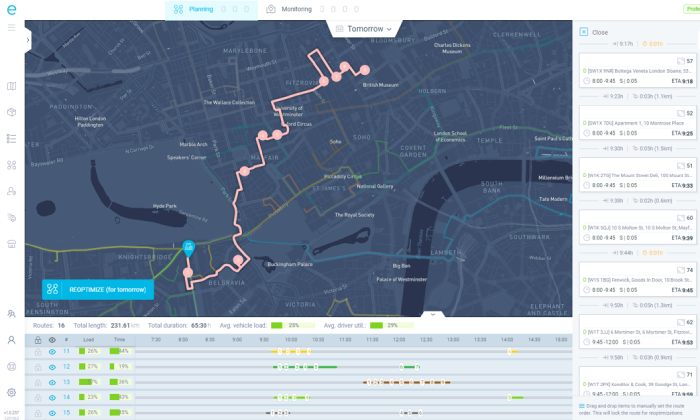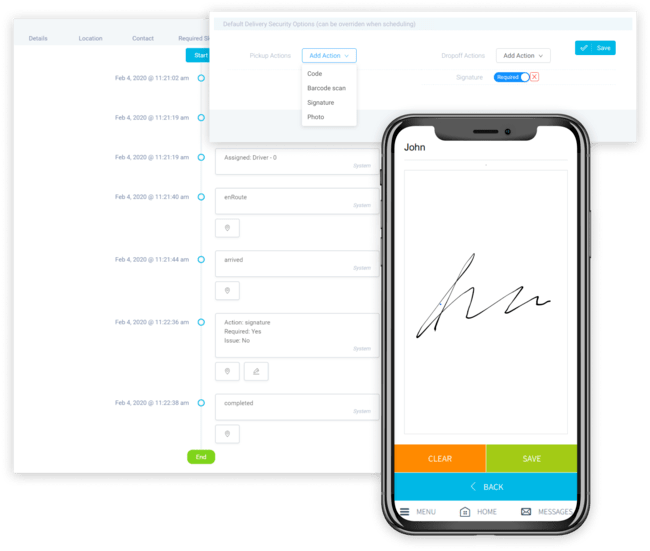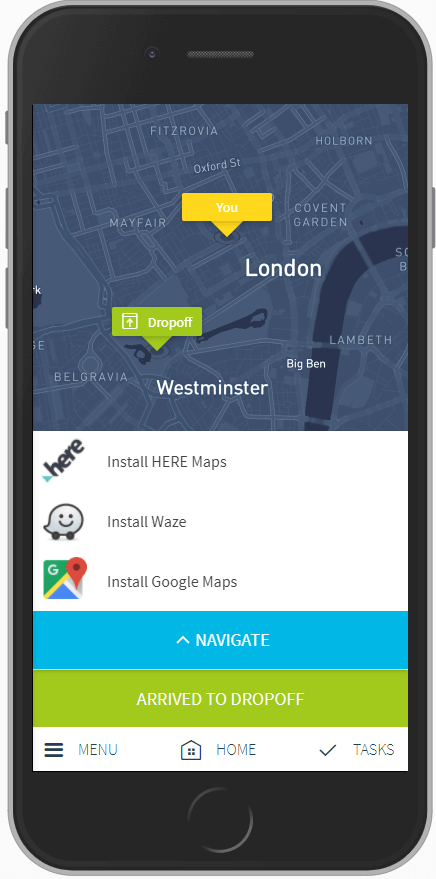How Dispatchers Benefit from a Delivery Driver Tracking App
See how delivery driver tracking apps can boost customer satisfaction, driver happiness, and operational efficiency effortlessly.
Home > Blog > How to Choose a Delivery Driver App?
Field ServiceIf a driver app is a key feature you’re looking for in delivery management software, this post shows you exactly how to choose the best delivery driver app
In this article, you’ll see how exactly to choose the Delivery Driver App.
Specifically, we’ll show you:
So if the driver app is a key feature you’re looking for in delivery management software, this post will help you make a better decision.
Let’s get started.
The delivery driver app is one of two components of the driver route planning software.
The other one is the delivery management platform (or dashboard).

The app is specifically designed for drivers. It has tools and features that make it easier for drivers to carry out their tasks.

The app enables drivers, couriers, and other field agents to access data about their routes, schedules, and tasks while they’re delivering goods or services to your customers.
The apps also should include tools, such as onboard navigation, automated reporting, and electronic proof of delivery (ePOD).
But at the same time, the delivery driver app benefits route planners and delivery operations managers.
The app is integrated with the software. The in-device geolocation allows users to track the positions of drivers on the map.
This allows planners and managers to use the software dynamically. They can use the system to schedule new orders, adjust routes, or dispatch drivers, all in real-time.
The app is a blend of various tools, including task management, reporting, ePOD, in-app chat, and navigation.
Think, Google Maps but with a much richer environment.
So while it’s difficult to do route optimization using Google Maps, with this software it isn’t.
The delivery driver app is integrated with the route planning software.
As soon as you map the routes and stops for a driver, the system uploads the information directly to the app.
Drivers can’t change the data using the app. Instead, they can only access it.
Technically, they use it as a task management system to see what they need to do and how to do it based on your plans.
The app also relies on mobile data, geocoding, and GPS to locate the device on the map.
This enables you to track driver progress in real-time, without the need for any onboard vehicle telematics. But it can integrate with telematics systems, as well.
Other than that, the driver delivery app works like any other app you have on your phone.
You download the app via Google Play (for Android devices) and the Apple Store (for iOS).
Then, you install it on the device and connect it to your main account.
You can then use the dashboard to manage users (drivers and delivery agents) and create assignments.
The app displays all of that information on a map. (Which you can integrate with Google Maps or Waze, as well)
While the in-app menu gives drivers access to tools they need to complete these tasks.
#1 No need for manual dispatch
#2 Better driver navigation
#3 On-demand order and customer information
#4 Less communication between teams
#5 Enables driver-customer communication
#6 Up-to-the-minute reporting
#7 Electronic proof of delivery
Are you still manually planning deliveries?
Let’s be honest for a second: manual dispatching is a thing of the past.
It’s impossible to think that any e-commerce would be possible without automation.
It’s just as impossible to think that Amazon other retail giants would be where they are without it.
And in 2020, it became clear just how important technology was, as businesses relied on delivery software to survive COVID-19.
That’s why automation is the most significant feature of delivery management software.
Besides route planning, optimization, scheduling, the software also enables automated dispatch thanks to the delivery driver app.
Because you don’t have to use paper to create driver schedules, drivers can receive daily workloads much faster.
The app streamlines internal communication as well.
So, instead of physically dispatching each driver to a drop-off location, all you have to do is create a new task on the dashboard. While the system uploads it onto their app.
This means you don’t have to rely on fixed routes anymore.
You can plan deliveries as soon as an order request arrives, which drastically raises your rate of fulfillment.
A delivery driver app isn’t a run-of-the-mill navigation system.
Instead of distance and calculating the shortest path between point A and point B, the software determines the quickest route between two stops.

This improves navigation, as drivers spend less time on the road by avoiding situations that affect the speed of fulfillment, such as traffic congestion.
From a business point of view, this means lower cost per delivery and increased operational capacity.
(Even when delivery demand exceeds your capacity)
But the driver app allows drivers to navigate the last mile more efficiently, as well.
The maps on the apps use GPS and geocoding, which means the maps are always up-to-date.
Drivers can rely on the routes you plan for them because they are always accurate. And that means fewer missed deliveries due to incorrect directions.
Likewise, this type of software takes a cloud-first approach to delivery logistics.
Cloud technology allows you to store historical data and use it to improve navigation beyond the streets.
Drivers can find return customers simply because other drivers have already delivered orders to them.
And in urban environments, that can shave off minutes from the time it takes to locate customers in residential and office buildings.
The interest in on-demand delivery has been increasing steadily over the last few years.
Today, 70% of customers are willing to pay more for faster, more convenient delivery, according to delivery statistics.
While 57% of those customers also demand same-day delivery.
So that means you’ll have to increase your delivery offer to include additional options besides standard delivery.
And without the help of software, your company won’t be able to provide this kind of delivery experience.
With the help of driver management software, your teams won’t lose any time on unnecessary communication.
Delivery driver mobile app streamlines communication between teams with the help of the onboard chat.
Drivers can use the chat for internal communication with customer support and dispatch. But only in situations where it’s absolutely necessary.
For example, if a driver’s vehicle has problems on the road, he can use it to contact the maintenance team directly. (Without the need to go through standard channels)
Dispatchers can modify routes without actually having to speak to the drivers.
While dispatch doesn’t remain blind to the driver’s activities.
They can track the location of drivers automatically via the map on their dashboard:
But also receive reports as soon as drivers complete a task.
The onboard chat also allows drivers to get in touch with customers using a mobile app for drivers.
This allows your business to use delivery management software to improve customer experience.
For example, as a driver sets off to a drop-off location, he can send quick messages to customers telling them that he’s on his way.
Customers love direct communication like this because it gives them a sense of greater value.
At the same time, that personal interaction is what helps your business build relationships with your customers.
Customers will feel as if they’re doing business with a human being rather than a company.
And that can lead to repeat business, simply because they already know who they’re dealing with.
The delivery driver app allows real-time updates directly to dispatch.
This gives you a critical feedback loop when the drivers set off on their routes. But it also helps you stay on top of the operations.
When a driver is running late, for instance, or something surprising happens on the road, you can see this and alert customers about the delay.
This helps ease any tension on the customer’s part and makes life easier for your drivers.
Proof of delivery (POD) is important documentation that confirms that an item has been delivered to a customer. Just like a receipt.
But unlike traditional PODs, delivery driver apps have a built-in electronic (or digital) proof of delivery (ePOD).

So instead of collecting paper forms from customers and then handing them over at the end of a workday, drivers can send ePODs as soon as they get them.
Drivers can collect delivery confirmations by using several different methods:
All of this means that drivers can spend less time at the customer’s door, which improves their output.
While at the same time, it removes any delays usually associated with manual reporting.
And because all ePODs are stored on the cloud, dispatchers and fleet managers can easily access them whenever they need to.
Now that you know how route optimization software can benefit your delivery, it’s time to choose the best solution for your business.
One way to go about this is to look at the driver app.
To help you, we’ve listed the main features you should keep in mind when choosing the best driver app for your drivers.
Let’s take a look.
Before you even start thinking about the delivery driver app you need to choose the right software.
To do that, you should evaluate your operations:
Taking the time to fully understand your delivery will help you learn how to choose the right delivery management software for your business.
And if you choose a quality software solution, it’s bound to have a solid delivery driver app, as well.
We can’t stress this enough:
You should NEVER have to pay an extra fee to get access to the delivery driver app.
You’re already paying a lot of money to use the software. And the app is an essential component of route optimization solutions.
So if your provider wants to charge extra, or the app isn’t free to download, it’s better to walk away.
Delivery driver apps have to be available for all of your drivers. And that means they have to be available on ALL DEVICES.
So, when you’re evaluating what apps to choose, make sure that the route optimization app works for Android and iOS.
This ensures that everyone on your team can use the device. And that you won’t have to invest additional resources to equip simply because you want to automate your delivery.
The software should be able to integrate with any third-party apps that you use.
When it comes to the dashboard, you should be able to use APIs to connect it with a number of different solutions.
Primarily, you should make sure that it can integrate with a CRM, like Shopify or Salesforce.
But other tools such as a supply chain, inventory, and warehouse management systems.
This allows you to centralize your delivery operations, making it easier to upload data to the app.
But you should also be able to integrate the app with other smartphone apps.
Most importantly, you should have the option to connect it to Google Maps or Waze.

This gives drivers a familiar environment and makes it easier for them to transition to the app.
What type of delivery do you operate? Do you have an in-house delivery fleet? Or do you outsource and subscribe to a dedicated third-party logistics provider?
Whatever the case, the delivery driver app you end up choosing should support both internal and external delivery fleets.
If you outsource the delivery fleet, this can help you protect the reputation of your business.
But it also helps you to monitor the performance and cost of the external fleet.
This safeguards your delivery against additional costs. And it helps you maintain quality customer service.
If you own and operate the delivery fleet yourself, this enables you to streamline fulfillment. And take advantage of all the benefits we’ve mentioned before.
The average price of driver route planning and optimization software is $182.35 per month.
But, to be clear:
The cost will vary from provider to provider.
The price you end up paying for the software will depend on your contract, its length, how you want to be charged, and the capabilities you want to have.
But it will also depend on your delivery.
Primarily, providers may increase the price based on the type of delivery you own, its size, complexity, the area in which you operate, as well as your delivery volumes.
Keep all of this in mind when you start researching for solutions.
This is a difficult question.
Besides price, there is a lot to take into account when choosing driver management software.
Lucky for you, we can help.
See how delivery driver tracking apps can boost customer satisfaction, driver happiness, and operational efficiency effortlessly.
Manually planning routes for your drivers is a time exhausting - so here are 3 of the best driver schedule excel templates for your last mile...
Discover the strengths and limitations of Apple Maps for delivery drivers versus alternative navigation tools. Choose wisely for better routes.
Be the first to know when new articles are released. eLogii has a market-leading blog and resources centre designed specifically to help business across countless distribution and field-services sub sectors worldwide to succeed with actionable content and tips.
